 Adobe Community
Adobe Community
- Home
- InDesign
- Discussions
- Why do my JPEG file sizes shrink so dramatically?
- Why do my JPEG file sizes shrink so dramatically?
Why do my JPEG file sizes shrink so dramatically?
Copy link to clipboard
Copied
This has got me completely and utterly baffled.
I have an image that I saved using Photoshop as JPEG at max quality and on disk it is 12.3mb.
After placing it at 100% in InDesign that spread when exported as a PDF with images set to max quality is a mere 2.9mb. (The spread is two pages, the image on one and the month of a calendar on the other)
The image in Photoshop is 3900px by 2650px and at 300ppi it's 33.02cm by 22.44. It is converted to CMYK and saved as JPEG at max 12
In InDesign it's frame is 330.2mm x 224.367mm on a document of 318mm x 212mm with 6mm bleed all round.
When InDesign is exporting as a PDF it must be recompressing the JPEG? Yet it seems to be throwing away 10mb even at max quality (see below) Or is it that Photoshop is saving CMYK JPEGs wrongly and producing files way too big - I've always thought PS produces huge JPEGs once you convert them to CMYK
What tests can I do? Have tried various output settings, these are current
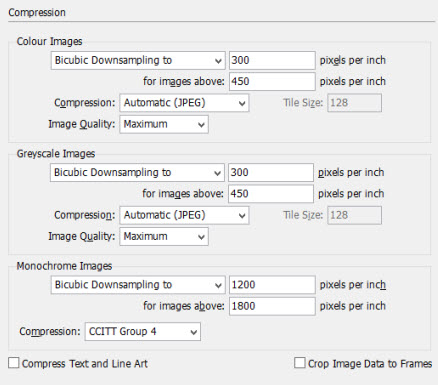
Copy link to clipboard
Copied
There is nothing lossy going on.
You've been told this so many times.
Get on with the job.
If you're worried about your image quality then saving to a jpeg firstly was a huge mistake.
InDesign is not creating a lossy version of your image - it's compressing it using all the techniques that Michael has clearly explained.
Copy link to clipboard
Copied
Can't understand you being so rude Eugene - I want to 'get on with the job' but the printer has expressed concerns at the small size of the PDF and the photographer is also concerned.
Michael did a great job of explaining how JPEG compression is able to achieve such significant reductions in files sizes and that would explain why InDesign crunches a 12mb jpeg down to 3mb. It doesn't explain why Photoshop doesn't do the same.
Is it that Photoshop isn't as good at saving to JPEG or that InDesign throws more info away?
Are both programs keeping the same amount of info but Photoshop is inefficient in dealing with JPEG?!
I've experimented by using TIFF.
The same 40mb CMYK TIFF saved by InDesign at Max quality is 3mb whereas Photoshop knocks it down to 10mb when quality is set to Max. In both cases the compression used is JPEG. Not Automatic, not zip.
Try it.
What happens if you export Page 1 of that documents as a CMYK JPEG from InDesign? Bigger or smaller than the highest quality PDF?
Copy link to clipboard
Copied
Don't mix "rude" with "exasparation".
I have taken my own time to look at your file.
No further compression has happened with your file.
If so worried about quality then saving as a jpeg from the start was your mistake.
If you don't like InDesigns compression of the images then talk to your printers about preparing an FPO (For Postion Only) and send them the original JPEG.
They can sway the image in the layout for your JPEG at the RIP.
That will quall your worries.
And you have nothing to worry about.
Press on with the job.
Get a chromalain proof get what you need to make the job happen the way you want.
But don't spend any more time on this. You're wasting your time.
Nothing to worry about.
Copy link to clipboard
Copied
I can probably proceed with the job but in order to satisfy my curiousity I still want to know why in InDesign does this. If this exasparates you please bow out of the discussion.
I've even ruled out Photoshop because just in InDesign the same data exported with JPEG as the compressor at quality of maximum is five times bigger using one export method than with the other.
Look at the file sizes below, both files created by exporting from InDesign. What's happened to the image data in the pdf version when the same image saved as a standalone JPEG at max quality is far, far bigger?
The PDF route must be compressing the image data more and it must be doing it with lossy compression because JPEG is lossy and that's what's selected. When embedded in pdf the jpeg is suspiciously more the size of an sRGB jpg of the same resolution.

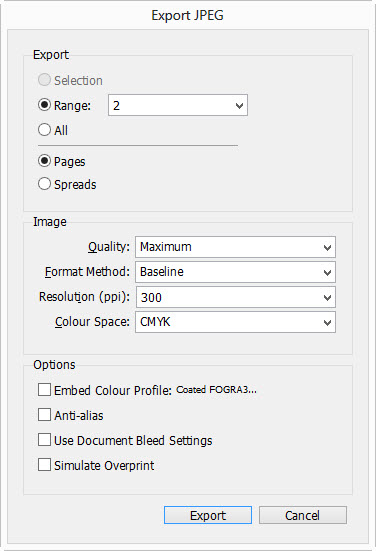
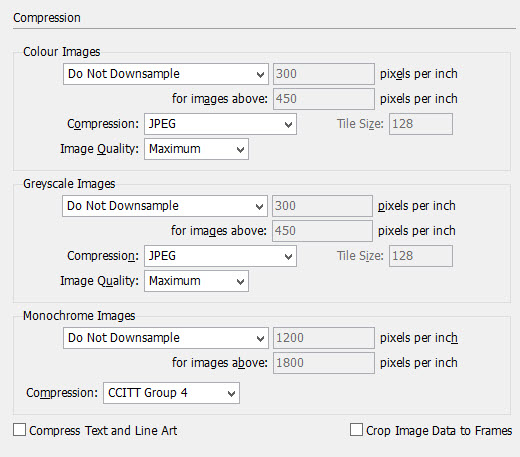
Copy link to clipboard
Copied
There's a trick you can use in Photoshop that shows the changed pixels in a compessed jpeg file.
I replicated your scenario by saving a 16"x25", CMYK image as 12 JPEG out of Photoshop. Then placed it in a same sized ID page and exported to PDF/X-1a with Maximum quality compression. I got a similar change in file size 23MB vs. 7MB.
If I place the exported PDF on the original PS JPEG I can then use the Difference blend mode and see any changed pixels. Like this:
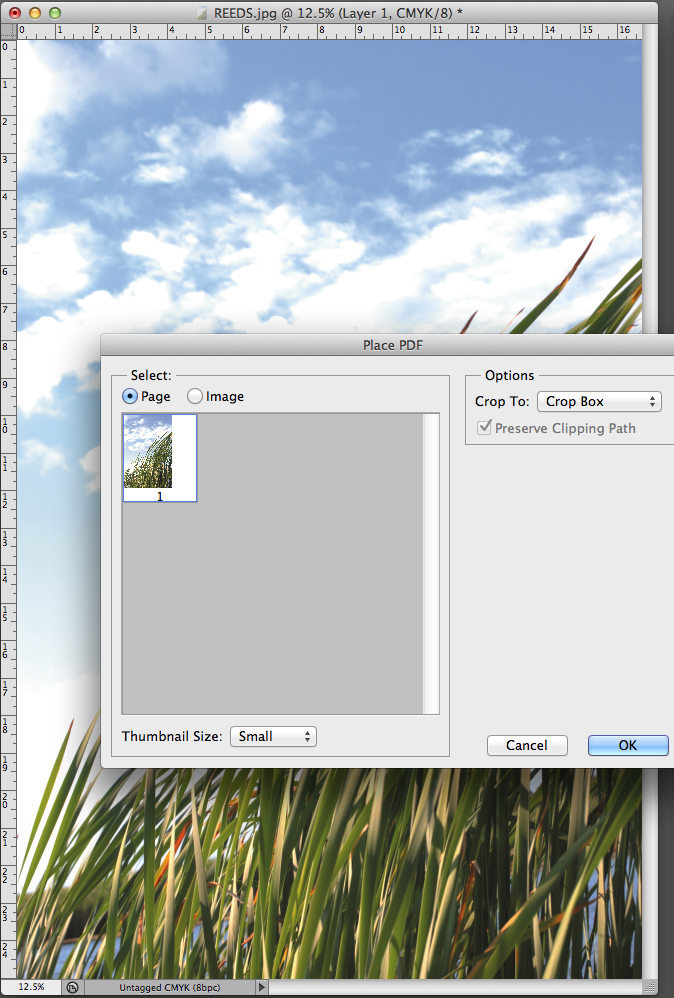
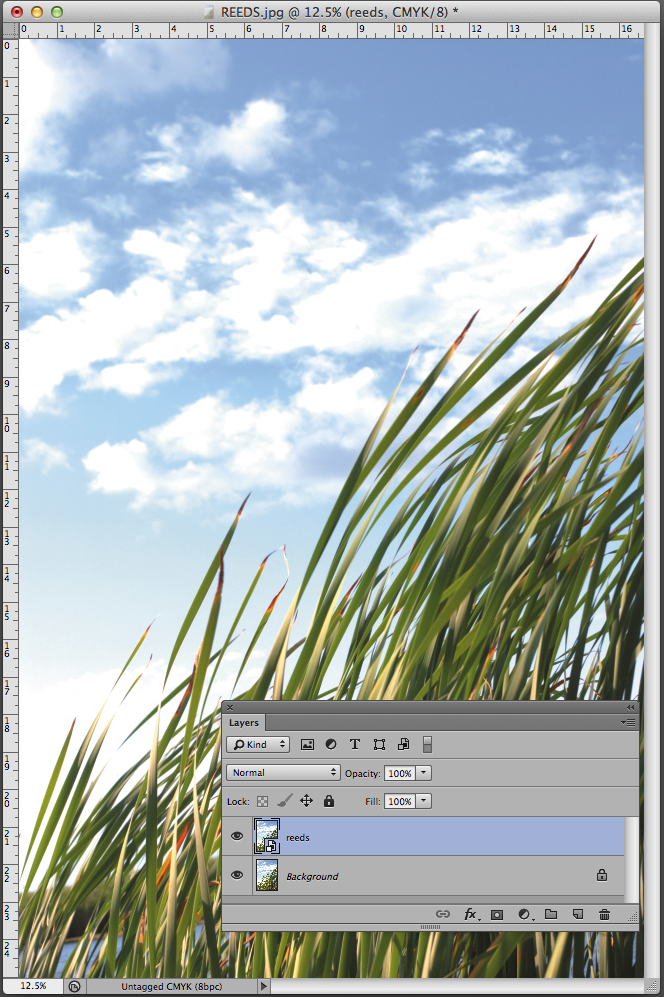

If the pixels were identical the Difference mode would show them as all black (0) and the Std. Dev. would be 0. The more compression the greater the number of non-black pixels, and the higher the Std. Dev. gray level showing in the Histogram.
You can see in my test the Std. Dev. is less than half a gray level, which would be impossible to detect in print.
Copy link to clipboard
Copied
That's super helpful Rob, I knew ID had to be throwing some more data away, great to know that visually it's not worth worrying about. Be nice to be able to tell InDesign to leave the original data alone though ![]() at "max" quality
at "max" quality
Copy link to clipboard
Copied
Don't use JPEG in the export.
Copy link to clipboard
Copied
I have to Bob, I need to keep my file sizes under 20mb, my choice is 40mb per file without jpeg compression or 3mb with, Chris the photographer - who provided the 12mb original jpegs - is concerned I'm over-compressing when exporting ![]()
Copy link to clipboard
Copied
is concerned I'm over-compressing when exporting
It looks to me like PDF simply has a better compression algorithm and you want to take advantage of it. You could ask the photographer to provide .psd so there's only one round of compression, but there's no press condition where half a gray level would be visible—I'm sure you would have variations larger than that within the press run.
Copy link to clipboard
Copied
Then why is he sending you JPEGs? Seems a bit crazy to be sending those
and then worrying about what JPG does to a photo.
Copy link to clipboard
Copied
(Referring to Mike Witherell., #19)
Mike, your description is correct for RGB images. Here are some additional illustrations:
http://docs-hoffmann.de/jpeg131200.pdf
For CMYK images a decomposition Luminance-Chrominance (Y-CbCr) would destroy
the black generation. The problem can be overcome by compressing each channel
C,M,Y,K independently as a grayscale image.
Edited:
Very little reliable information can be found. It seems, for this application the color space
YCCK had been invented, which is a combination of Y-CbCr plus a single channel for K.
Compressing the first part as usual and the second as a single grayscale should work,
preserving the black generation.
http://software.intel.com/sites/products/documentation/hpc/ipp/ippi/ippi_ch6/ch6_color_models.html
Of course these issues are not really relevant for the actual thread.
Best regards --Gernot Hoffmann
There is a discussion, initiated by Amy, in the Photoshop Forum as well:
Copy link to clipboard
Copied
Gernot,
I had this summary in my Photoshop ppt of notes now already for many years. Probably originally I was quoting from your writings, but I don't remember. I should acknowledge that I am not the originator of these thoughts. I just share them in the classroom.
Copy link to clipboard
Copied
Mike,
sorry if you thought I wanted to blame you.
I wanted merely
a) add some illustrations
b) add my opinion about CMYK-JPEGs, and how to preserve the black generation.
These thoughts are quite common. Really no reason to refer to any source!
Best regards --Gernot Hoffmann
Copy link to clipboard
Copied
Amy2014 wrote:
This has got me completely and utterly baffled.
I have an image that I saved using Photoshop as JPEG at max quality and on disk it is 12.3mb.
Your disk image is not JPEG-compressed; it's a TIFF file with an EXIF wrapper. The large difference is because (1) the original image is *not* compressed, and (2) in the PDF it is *highly* compressed (with a slight loss of data). And (3) there is a slight size reduction -- 3900 x 2650 in the original, 3765 x 2513 in the PDF, so it's also 8.5% smaller (admittedly, not as significant as pts 1 and 2 combined).
Inside the PDF it is a JPEG, as confirmed by Acrobat Preflight -> Inventory. This shows it uses "JPEG compression (DCTDecode)".
For the original image, Apple's Preview (of all!) shows a 'TIFF information' field and says it's an uncompressed (!!) TIFF image. Examining the original file with a hex editor shows that this appears to be correct. (*)
You or your photographer presumably saved this from within Photoshop as a JPEG, but set the dialog options in such a way PS decided to save it in this format. Hold on while I check ... Hmm. By default, saving as TIFF preserves the original compression, and when saving it indeed says "None" in the Image Compression field. I wonder if the presence of EXIF information made PS work this way. Maybe someone on the PS forum can tell you that.
(*) Maybe not entirely true. For CMYK, the raw size would be 4 x 3900 x 2650 ~ 40 MB. If pressed, I could probably find out why this image is still only a quarter of that, but I think the main point is clear enough.
Copy link to clipboard
Copied
Jongware,
I had confirmed Amy's workflow with my own image. Data are here in #3:
http://forums.adobe.com/message/5740039
In my opinion, the JPEG compression settings in InDesign and Photoshop
are different.
It can be assumed that PhS qual.12 doesn't use color subsampling
but ID does. Color subsampling*) shrinks the file size for an RGB image
already by factor 1/2. For CMYK, which contains RGB=3/4 plus K=1/4
size the compressed size will be (1/2)·(3/4) + 1/4 = 5/8.
All the other compression effects are additional.
Furtheron it's very important to know, whether the CMYK profile (ca.2MB)
is embedded or not. In my example this is clearly mentioned.
I don't think that InDesign has an "improved" JPEG compression which
could explain the observed effects.
Best regards --Gernot Hoffmann
*) the most effective method uses only one of four value pairs Cb,Cr.
Copy link to clipboard
Copied
Gernot, sorry, I didn't follow the discussion all the way to the PS forum.
Nevertheless, my main point:
I don't think that InDesign has an "improved" JPEG compression which could explain the observed effects.
.. the original file was not JPEG compressed (even though the file name seemed to indicate that), and so that fact in itself does explain the huge difference.
Copy link to clipboard
Copied
Jongware,
in my case the original CMYK-Tiff had 47.5MB and the (so-called?) CMYK-Jpeg
had 12.8MB with embedded profile, which consumes about 2MB.
Thus we have a compression ratio of about 4, which is as expected for a highest
quality JPEG and an average photo.
Amy's example shows about the same result. How can this be achieved "without
compression"?
Best regards --Gernot Hoffmann
Quoted from my PhS post:
Start:
RGB-Tiff 4000x3000 px, 34.3 MB (numbers are rounded)
Convert:
CMYK-Tiff 4000x3000 px, 47.5 MB
Compress by PhS CS6 Qual 12:
CMYK-Jpg 4000x3000px, 12.8 MB, with profile ISOCoated-v2-eci
Place in InDesign CS6:
Export as PDF using High Quality Print (4) *)
CMYK-PDF 4000x3000 px, 3.32 MB, no profile embedded
Analyzer Quite-A-Box-of-Tricks says: JPEG compressed by Photoshop Quality 10.
That's not necessarily correct, therefore a test:
Again
CMYK-Tiff 4000x3000 px, 47.5 MB
Compress by PhS CS6 Qual 10, no embedded profile
Size 4.37 MB
*) same result with explicit settings for highest quality.
Copy link to clipboard
Copied
The length of this discussion precludes me from reading every post, but have we found out if there is any resampling?
Copy link to clipboard
Copied
In my example, which reflects very much the behaviour of Amy's workflow,
happens no resampling.
CMYK-PDF 4000x3000 px, 3.32 MB, no profile embedded
Of course, a good question. Issues like this are the reason for working
out my example fully under control.
Im checking always immediately the number of pixels, resolution, compression
and color space by Quite a Box of Tricks (which is for this purpose faster
than Acrobat Pro).
As far as I can see, exactly one answer by the Adobe staff would be very
helpful:
Are the maximum quality settings identical in Photoshop's and InDesign's
JPEG compression?
Best regards --Gernot Hoffmann
Copy link to clipboard
Copied
I ran my difference test on the OP's CMYK image and the deviation is only .41 level:
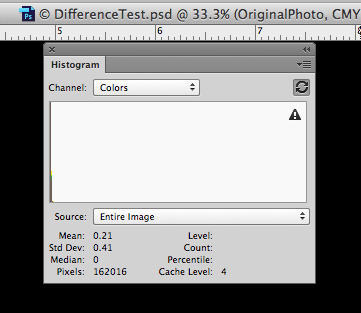
Here's a folder with the test:
Copy link to clipboard
Copied
I made different pdfs from the same file.
18mb JPEG with maximum compression
No Compression - file is 70mb
Jpeg = 1.9mb
autojpeg = 1.9mb
zip = 25mb (circa)
Opened each of the images in Photoshop from Acrobat
All files show the exact same file size, dimensions, resolution and there is no difference when viewing in Photoshop.
Copy link to clipboard
Copied
Rob,
I think you're right – PDF delivers a better quality than Photoshop for the same file size.
I don't know the reason.
Below are the details, everything for my example.
Best regards --Gernot Hoffmann
------------
PhS CS6, ID CS6
All images and the PDF:
4000px x 3000px
CMYK
No profile embedded (exception: the TIFF source)
All tests:
Image > Calculations > File1 Cyan > File2 Cyan > Subtract > Offset 128 > Scale 1 > New channel
Histogram > alpha1 > update > Sigma (standard deviation)
Source: TIFF, Size=47.5 MB
Image A: JPEG, Qual=12 Size=11.1 MB
Image B in PDF: InDesign > Image A placed > Export as PDF with JPEG Qual=Max > Size=3.31 MB
Image C: Extracted from PDF using the tool 'Touch Up Object' > Edit by PhS
Image D: JPEG, Qual=10, Size=4.73 MB, a PhS child of A
Image E: JPEG, Qual=08, Size=2.49 MB, a PhS child of A
Results:
1) C versus A: sigma=1.01
2) D versus C: sigma=1.78
3) E versus C: sigma= 2.03
4) D versus A: sigma=1.90
5) E versus A: sigma=2.61
The size of B is between the sizes of D and E
The quality of B is better than the quality of D or E
Copy link to clipboard
Copied
Hey hi @ChrisMix86You can try adjusting the compression setting in InDesign to see if it affects the file size further and also check that the JPEG compression settings in Photoshop are optimized for web or print use to avoid unnecessarily large file sizes.
Copy link to clipboard
Copied
This post is 11 years old!
-
- 1
- 2




